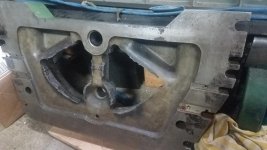bsg
Titanium
- Joined
- Jan 17, 2003
- Location
- Imlay City, Michigan
I did some checking on the sizes available of Dura-Bar. There is one size that would make an excellent sub-table for a Deckel Rotary Table: 2.5" x 8.25". It comes in 72" lengths, which would yield (5) 14" long pieces. The base of the rotary table is a little bit less than 8"x12", so an 8x14 sub-table would work fine. The 2.5" height would also be enough to raise the handles and index plate above the surface of the mill table, and the top of the rotary table would end up 6.5" above the mill table. That also means that on an FP2NC, the top of the rotary table would be about 3" above the center-line of the horizontal spindle with the table at the top raised as far as it will go. Which is good, it would allow a reasonable size cutter below the bottom of something on the rotary table (a limitation I ran into earlier this week using 4" parallels).
If anyone else would be interested in going in on a purchase let me know.
-Dave
I would be interested depending on price?
Kevin





